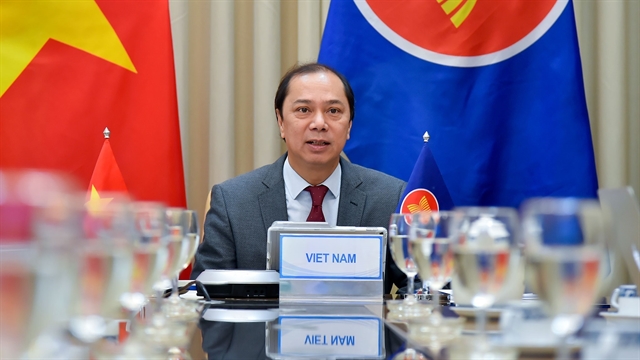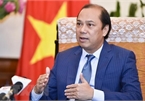 |
|
Nguyen Quoc Dung, Deputy Minister of Foreign Affairs of Vietnam.
|
Below is the full text of his article.
“2020 drew to a close with complex and multidimensional upheavals that have not been witnessed in the regional and global politics and economy in a long time. As Vietnamese Prime Minister Nguyễn Xuân Phúc put it, the “ASEAN 2020 ship” has navigated through “rough sea and tumultuous storms of the COVID-19 pandemic, but rocked by economic recessions, disrupted trading activities, and growing strategic competition between major powers in the world that is playing out right within the region.
Undaunted, the “ASEAN 2020 ship”, under the steering of Việt Nam and the cooperation from member countries and partners and friends, have strongly overcome the adversity, reaffirmed its central position in the region, and elevated its reputation and profile in the international arena.”
ASEAN Centrality: the fruit of long, patient building process
The notion of “ASEAN centrality” started to gain traction among the group’s member countries since around 2005-06 when ASEAN perceived a growing pressure and sway from outside partners.
In that context, centrality is understood as that ASEAN always coordinates perspectives and actions in its cooperation relationship with partners so as to maintain the group’s ‘main driver’ role, as well as uphold the group’s central role in shaping regional cooperation structures based on ASEAN-led forums and frameworks.
With the birth of the ASEAN Charter, ASEAN centrality has been codified – the notion becoming both the goal and guiding light for ASEAN activities.
From the five founding members, ASEAN had gradually opened up to the current 10 countries of Southeast Asia, transforming the region from a state of conflict, division, and full of doubts in the Cold War era to a region of peace, solidarity, cooperation and development – making ASEAN one of the world’s models of regional cooperation. In addition, ASEAN has set up dialogue partnership with nine countries and one international organisation (the United Nations) and one important regional player (the European Union).
Other than bilateral frameworks, ASEAN also established many important forums and mechanisms – including ASEAN Regional Forum (ARF), ASEAN+3, and East Asia Summit (EAS) – which help bind partners more strongly into regional dialogue and cooperation processes.
ASEAN centrality also comes from initiatives, ideas, and agenda for the sake of mutual benefits that the Association proposes and leads the implementation, based on common principles and code of conduct that the Association has built as well as on the interests of the dialogues and cooperation brought about by the many mechanisms and forums that the Association has set up.
From ASEAN’s proposals, a series of regional cooperation and linkage programmes have been implemented such as: free trade agreements, connectivity plans, etc. Dozens of external partners have voluntarily participated and committed to complying with the principles and provisions set out in the Treaty of Amity and Cooperation in Southeast Asia (TAC), which is considered ASEAN’s “set of rules” in governing the conduct of countries in the region.
In joining ASEAN's cooperation mechanisms and frameworks, major countries not only reap benefits from various cooperation plans and programmes with ASEAN, but also have opportunities to meet, converse and work together. ASEAN's major forums and events – with a friendly atmosphere of dialogue and cooperation – have served as a good environment for leaders and ministers of major nations to have bilateral meetings to build trust and overcome differences.
From the achievements and experiences, in 2015, ASEAN concretised the “ASEAN centrality” notion into five key aspects – the central role within an independent and resilient ASEAN, a central role in the face of hot-button issues in the region, a central role in relations with major countries and other dialogue partners, a central role in the regional structure, and finally, a central role in participating in and resolving issues and challenges of global concerns.
2020: ASEAN centrality reaffirmed in the face of unprecedented challenges
“Adversity tests strength as fire test gold,” in 2020, against unprecedented challenges, the ASEAN centrality has been fully asserted in every way.
First, the theme of ASEAN Chairmanship Year 2020 – “Cohesive and Responsive” – showcases all aspects of the “ASEAN centrality”.
If solidarity, cohesion, and strong cooperation serves as a solid foundation, then timely responsiveness and adaptation is the way for ASEAN to continue to reaffirm its leading role in the region.
Overcoming the difficulties caused by the COVID-19 pandemic, ASEAN continues to firmly maintain the momentum of building the ASEAN Community, promoting the effective implementation of plans and programmes to realise the goals stated in the ASEAN Community Vision 2025.
Facing the risk of cancellation of ASEAN summits and meetings due to interrupted aviation activities, under the chair of Việt Nam last year, ASEAN has flexibly and promptly moved hundreds of conferences and meetings to virtual format. In 2020, more than 550 conferences and meetings have been held in this manner. This not only helped carry on the momentum of dialogue and cooperation in the region, but also helped shape a new way of operation, helping to enhance ASEAN’s resilience and flexibility.
Along with that, ASEAN continued to assert an important role and voice on essential issues related to regional peace and security. Faced with the adverse ramifications of increased competition and friction among major powers, on August 8, 2020, ASEAN Foreign Ministers issued a Statementon the Importance of Maintaining Peace and Stability in Southeast Asia.
In this Declaration, the ASEAN Foreign Ministers affirmed their strong, shared commitment to the maintenance of peace, security, neutrality and stability, the rule of law, contributions to strengthening mutual trust and confidence, and working towards building an open, transparent, inclusive and rules-based regional architecture, thereby reinforcing ASEAN's central role.
With complex issues such as the South China Sea (known in Việt Nam as the East Sea), ASEAN always works closely, maintains consensus and a common voice. In particular, in 2020, the role of international law was emphasised by many countries, especially the role of the 1982 United Nations Convention on the Law of the Sea as the legal framework governing all activities in the seas and oceans.
ASEAN has been continuing to expand and deepen existing partnerships, including agreeing to upgrade ASEAN-EU relations to a strategic partnership level, while at the same time, proactively deploying many measures to strengthen relations with other partners.
In 2020, ASEAN agreed to grant the status of development partners to Italy and France, opening opportunities to further promote cooperation with these countries in the coming time. As many partners have been seeking to draw ASEAN into their own regional initiatives and strategies, ASEAN has persistently upheld the goals, principles and priorities outlined in the ASEAN Outlook on the Indo-Pacific, and at the same time, mobilised these very partners to support and back ASEAN in implementing the directions and priorities stated in the Outlook report for the mutual benefit of peace, stability, and development.
At the global level, ASEAN has made great efforts to participate and contribute to the resolution of common challenges and problems. Many proposals on promoting sustainable development, combating climate change, ensuring gender equality and women’s empowerment have been approved and put into practice.
ASEAN cooperation with the UN and relevant authorities continues to be strengthened. In addition, the conclusion of the negotiations and inking of the Regional Comprehensive Economic Partnership (RCEP) not only will bring practical benefits to the participating countries but also this is an important contribution of ASEAN in the efforts to strengthen trust and create more impetus for multilateralism and the multilateral trading system.
“ASEAN centrality” is both the goal and the guiding principle of ASEAN activities. The central role is not an "privilege" that is automatically available to the Association, the bloc can only create and nurture its “centrality” through its prestige, sincerity and the stance of “neutrality, peace, dialogue and cooperation” that has been constructed from the relentless efforts of ASEAN during its long journey of formation and development. Through unprecedented hardships and challenges, “ASEAN centrality” has been consolidated and strengthened in 2020.
In its capacity as ASEAN Chair in 2020, Việt Nam has accompanied the group to overcome never-before-seen hardship, and reaffirmed its position as one of the “core”, “leading” members who actively build and shape the rules in ASEAN and the region.
As Vietnamese Prime Minister Nguyễn Xuân Phúc said at the review meeting of the ASEAN National Committee 2020, on December 11 last year, Việt Nam has truly proved a “solid and reliable source of support, especially in the moments when ASEAN grappled with arrays of difficulties and challenges.”
These results will create an important foundation for Việt Nam and ASEAN countries to continue to steer the "ASEAN ship" to conquer all challenges, become more connected and boast higher adaptive capacity, and achieve new victories in the coming time.” — VNS

Vietnam’s chairmanship helped ASEAN assert centrality in region: Official
In 2020, under Vietnam’s chairmanship and thanks to the joint efforts of member countries, partners, and friends, ASEAN managed to weather challenges, strongly affirm its centrality in the region,